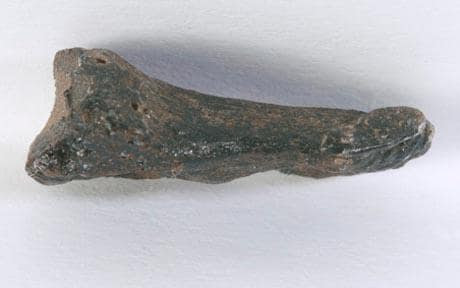I had already decided to abandon posting a combined Shroud of Turin News each month and instead post individual news articles on the Shroud as I become aware of them.
Then yesterday I discovered that my January News' comments on Italian artist/art restorer Luciano Buso's claim that medieval artist Giotto di Bondone (c. 1266-1337), created the Shroud of Turin image, can't be easily found on Google (I did find it eventually), presumably because Google gives a higher priority to indexing the actual titles of blog posts, not sub-titles within posts. Also, I became the owner of a smartphone (Samsung Galaxy SII) for the first time the other day and I have a new appreciation of shorter posts!
So I am reposting that article excerpt and my comments below.
"Luciano Buso - an artist who cracked Giotto Code," The Voice of Russia, Jan 31, 2012 ...
[Left: Statue representing Giotto, outside the Uffizi Gallery in Florence, Italy: Wikipedia]
... Luciano Buso – an artist and art-restorer from an Italian town of Treviso – is confident that it [The Shroud of Turin] was a replica of the original Shroud made by a great Italian medieval artist Giotto di Bondone. ... Mr. Buso, how did you manage to establish that the famous Shroud of Turin was created by Giotto given the fact that you did not have direct access to it? During this study I only used the same methods that I have already used during my examination of other pieces of art ... All of these artists used a special technique of hidden writing. And in the case of the Shroud it was sufficient for me to operate with its photograph only. In your opinion, why of all the great medieval masters it was Giotto who was honored with the job of replicating the burial cloth of Christ? As I have written numerous times, in my mind Giotto was chosen as a famous artist of his time whose name was well known primarily due to his popularity and his craftsmanship. ... Are you ready to insist on your point of view? If yes, what counter arguments are you going to use to prove your point? The fact that all theories related to the Shroud of Turin are to be proved invalid to some extent became obvious to me back in 1980s when a group of world renowned scientists who performed carbon dating test on a small piece of the cloth put the Shroud's origin around 1280-1320. ... I can say only this: those who want to doubt my theory will also have to appeal the results of all my work to study hundreds of pictures painted between years 1300 and 2010. In all those I found hidden writing. There is a book about to come out in which I give a precise and detailed account of all examples of hidden writing I have encountered. What I don't understand is this: what's the point of denying my theory that proves that Giotto created the Shroud of Turin in 1315 if the existence of these hidden writings is obvious. ...Busco's "hidden writing" in the case of the Shroud is nothing more than "several veiled appearances of the number 15" which supposedly "indicate Giotto created the Shroud in 1315"(!):
"An art critic has claimed the Shroud of Turin, an ancient linen sheet revered by some Christians as the burial cloth that wrapped Christ's body after his crucifixion, was created by the Italian master Giotto ... After months of careful examination of photographs of the Shroud - the relic is kept locked away and not available to be viewed unless on special occasions - Luciano Buso... says that several veiled appearances of the number 15, hidden in the fabric by the artist, indicate Giotto created the Shroud in 1315 - and that it is a copy of the original which had been damaged and was then lost over the centuries." ("Shroud of Turin is a fake created by famous master Giotto, claims Italian art expert," Daily Mail, 8th June 2011).
Sounds like Busco's `theory' is more about his making money through sales of his new book than any actual artistic or historical evidence that Giotto di Bondone (c.1266-1337) painted the Shroud. I could point out the usual evidence that invalidates all claims that the Shroud is a painting, i.e. there is no paint or pigment on it that accounts for its image, the image is extremely superficial ("one fifth of a thousandth of a millimeter"), it has no outline and no directionality, it is a photographic negative which was unknown until photography was invented ~600 years later in the early 19th century, etc. But I will quote The Guardian's art critic, Jonathan Jones, who answers "Nah" to the question, "Did Giotto really paint the Turin Shroud?":
"Claims that the shroud was a 14th-century hoax by Giotto may be far-fetched, but at least they get us talking about this profound and brilliant painter ... But why would he want to? Nothing in what is known of his life or art suggests any such activities or interests. ... the idea of Giotto taking time off to concoct a relic seems silly. He was too well-known, too ambitious and too profound to either want to do it or get away with it unnoticed." ("Did Giotto really paint the Turin Shroud? Nah," Jonathan Jones, The Guardian, 9 June 2011).
Stephen E. Jones, B.Sc., Grad. Dip. Ed.
My other blogs: CreationEvolutionDesign& Jesus is Jehovah!














